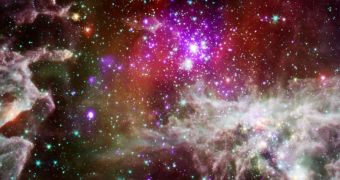The vast majority of new stars is born inside nebulae, massive formations that hide their creation from outside observers by shrouding the blue stars in massive volumes of billowing gas and dust. Now, experts manage to get a glimpse inside one such structure, without using infrared telescopes.
The latter are generally used to analyze the heat piercing through the clouds, but astronomers detected that the star cluster and nursery NGC 281, informally known as the Pacman Nebula, lies about 1,000 light-years above the plane of the Milky Way.
What this implies is that we no longer have to look through thick dust clouds in order to see it, but rather observe stellar formation processes in optical wavelengths. In addition, the object is also relatively near-by at around 9,200 light-years.
The name Pacman Nebula refers to its appearance when viewed in optical wavelengths. This NASA Spitzer Space Telescope image is taken in infrared, so the portion of the structure that gave it its appearance now shines brightly.

 14 DAY TRIAL //
14 DAY TRIAL //